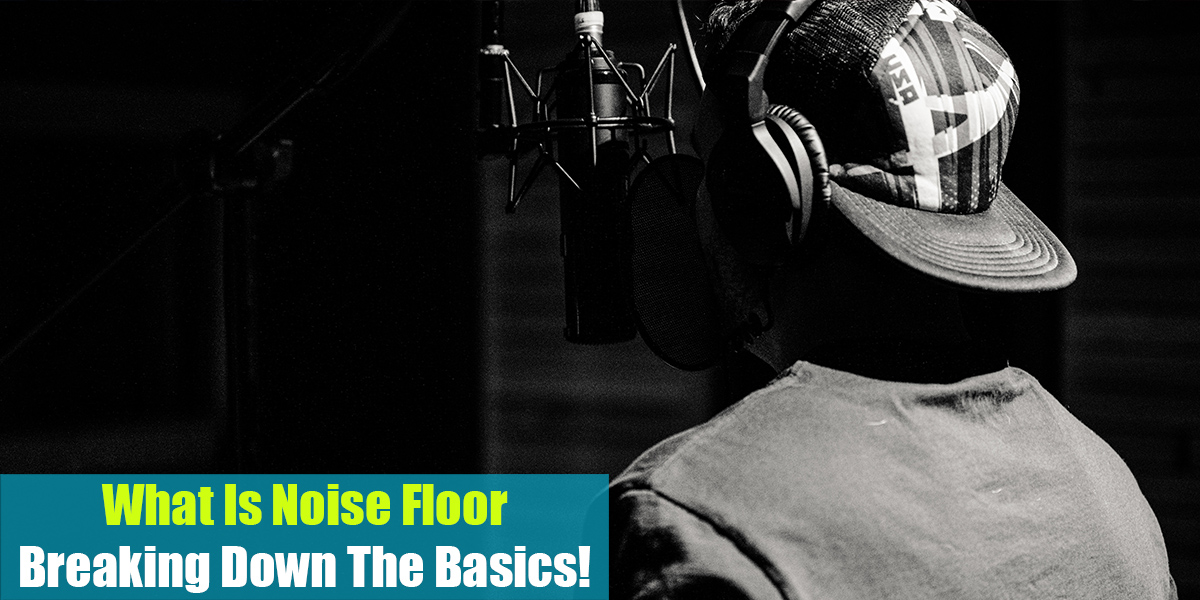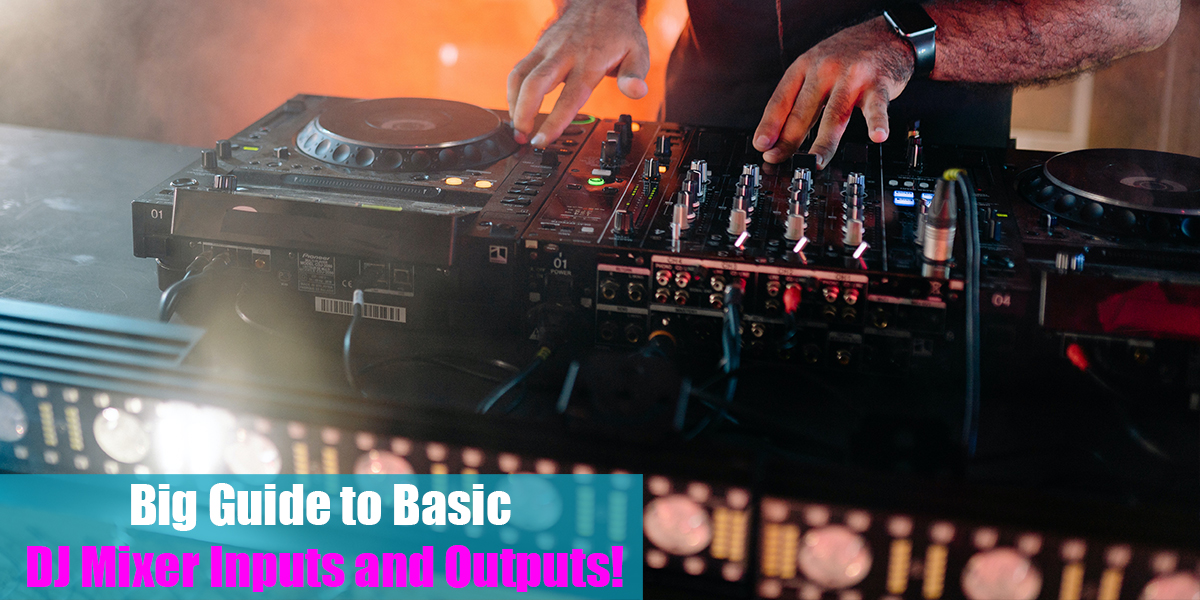How To Use DJ Mixer
Introduction
DJ Mixer. The unit that confuses the most mixers, no matter if they are beginner DJs or experienced ones. If you are in front of a new DJ mixer, it takes some time to learn all the features before being comfortable with it.
The truth is that experienced DJs will get used to it in a brief time and start using it properly, but beginner DJs will need some time since there is a learning curve to this core unit of your DJ setup.
Well, in this article we are going to cover everything you need to know about a DJ mixer and try to simplify its function for everybody that wants to learn the DJ craft to find it easy once they are faced with a new and modern mixer on a DJ gig.
So What is a DJ Mixer?
Any DJ setup would not be complete without a mixer. Mixers enable DJs to perform many of those cool DJ tricks by mixing and routing sound coming from the decks. To connect the players to the outputs of the mixer, channel 1 and channel 2 have been set up.
Two turntables, CD players and decks, and laptops, for example, fall into this category. Interestingly, each channel has multiple inputs. Generally, there are two types – Phono, which connects to a vinyl record player, and Line In, which connects to a computer or CD player. It is possible to select which input a channel receives the signal from by means of special input switches.
Basically, you cannot mix music without having a DJ mixer, no matter if you connect digital DJ equipment or CDJs and vinyl turntables. Nowadays, with modern DJ mixers, you can even control the DJ software and be completely independent of touching the computer.
Now we are going to dive deeper into the basic features that any mixer has in order to get familiar with them and know what to expect when you stand in front of a mixer preparing to mix music for the first time.

Basic Features
DJ mixer might be confusing at the start, so we are going to talk about most of the features that mixers have in order to simplify it for you and use it right.
Master Fader – This is the central and final knob that controls the overall volume that comes out of multiple audio inputs on your mixer. From here, you are controlling the final output volume that goes to the speakers or to the amplifier.
The Crossfader – Every typical DJ mixer has this fader. Some mixers even do not have this one, but they are the older versions. Also, every DJ controller now has this fader and it is nothing new to a mixer. So what is the crossfader? This is the slider that moves the focus from one channel to the other. The audio fades out from the left one for ex. and fades in the right track.
As the name states, this is only a fader and doesn’t add volume or cut it from the overall volume sum. The audio mixer fader simply serves the purpose to transition from one track to the other for impeccable mixing.
This is also a crucial part for turntablist and scratching DJs because they rely mostly on the crossfader to make the right cuts and shape the scratches.
Channel Faders – In the center of any DJ mixer you will be able to see at least 3 sliders. 2 vertical ones and one horizontal slider. Well, the channel faders are the vertical ones that are volume controls or channel volume for the left and the right player that is connected to the mixer.
These are apart from the master volume on the mixer and controlling the volume once the master volume is set. On top of that, you will have additional gain controls for each channel that will help you to trim the audio to your liking and to be within the limits without bursting any speakers.
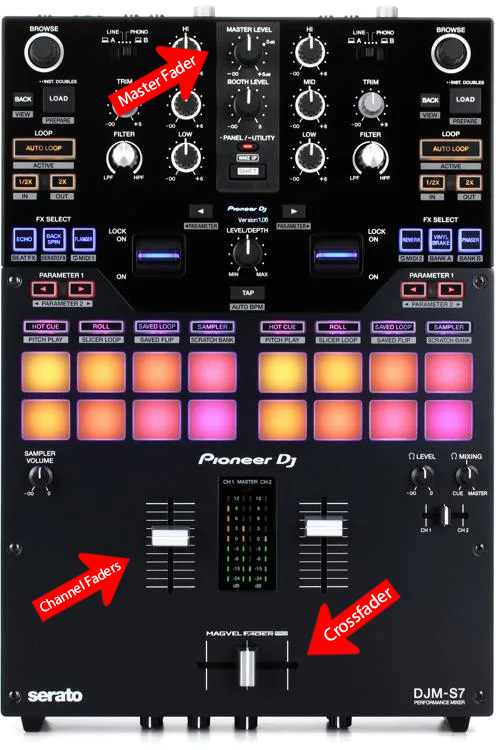
Effect and Filter Section – The effects section on a mixer has many various effects that can be applied to both the right and the left channels. To start with the regular ones, we have the filter knob, that when turned clockwise is an HPF and when turned anti-clockwise is LPF.
Other regular filters are the frequency ones, that are boosting or cutting the low, mid, and high frequencies of the track. Each filter has its own specifications that you will be able to look into the manual you will get from the manufacturer.
On top of these basic effects and filters, more advanced effects that can be found on a mixer are delay, reverb, backspin, doubler effect, phaser and flanger, and more. Depending on the mixer, you will be able to use one or more of them at the same time, all based on your decision and skill of DJ mixing. With these effects and filters, possibilities are endless and this is what separates the regular from the advanced DJ.
Metering – Usually between the channel faders, you will be able to find the VU meters or LED lights that are showing the volume of each channel. This is really helpful to show you how hot are your tracks and do you need to adjust the volume of the tracks. One piece of advice here: RED IS BAD! You know what I mean.
Headphone Level – In the center of the mixer, most of the time between the EQ knobs of each channel, you will be able to find the headphone level knob that adjusts the volume of the control you have to the signal in your DJ headphones.
This is really important when mixing because you need to have control and check how the tracks work with each other before mixing them together.
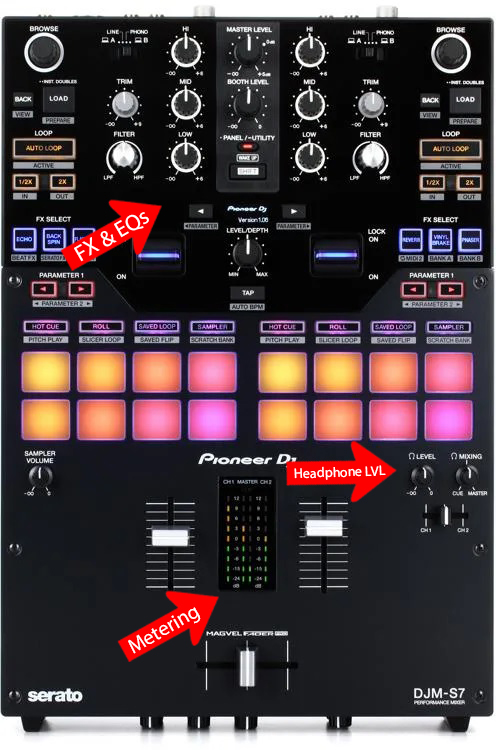
Well, here we covered all the basic features that the mixer has. We are not mentioning the audio inputs and outputs, the audio interface it has embedded inside, and the specifications of the mixer, because we will leave that for some other article.
But there are some other advanced features that some DJ mixers have that are worth mentioning in this section of our article. Also, some of these features can be found on DJ controllers as well, so it is good to know it.
Big Guide to Basic DJ Mixer Inputs and Outputs! (2023)
What Are Rotary DJ Mixers: Breaking Down the Basics! (2023)
Big Guide on How To Connect External Effects to DJ Mixer! (2023)
How To Choose a DJ Mixer: Great 9 Factors to Consider!
Setting Volume Levels on DJ Mixer: Great Guide! (2023)
Additional Features
Pads – This is something new that now most of the mixers are having and are important for the DJ setups that are more advanced. To mention the features of these pads will take us another article to write, so we are going to stick with the basics of them.
You can set your hot cues and initiate them, have slicers that will loop the timing of the loop, and some of them have some scratch banks that to be honest are not that widely used, but it also has samples and sound effects, where you can load some samples or cut the song to specific times for mixing purposes.
Once you get used to these pads, you will use them all the time and you will be able to create interesting mixes and transitions with them.
Browse and Load Feature – This is a feature that modern digital mixers have that are there to help us locate the songs we want to put in on a digital deck on the software, to be prepared to be mixed in. It is simple and the name of these knobs says it all.
The browse knob helps us browse in the crates and find the song we want. Usually, they can be pressed, going in or out of a folder. The load button is loading the track. Simple as that. The left load button works for the left channel, and the right button for the right channel. Easy.
Booth Control – There will be a need for a separate booth control for DJs playing at medium to large venues. The mixer has additional outputs for plugging in booth monitors (speakers).
There will usually be a single knob on the booth control that can be used to control the audio channels on booth monitors separately from the main master volume control. Many two-channel mixers also have booth outputs, as well as every four-channel mixer setup.
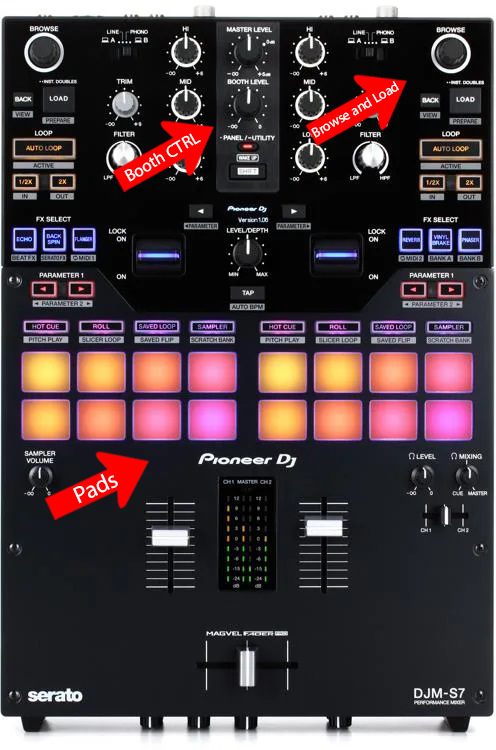
How To Actually Use The DJ Mixer?
Make sure that you set your DJ mixer properly before proceeding with the mixing process. In order to set it up, you need to plug your output into the mixer and input it into the mixer’s input. The inputs should be connected to the correct channels. Mixers with one or two channels are easily connected by plugging them into the appropriate connectors and arranging them in a line.
The transition from a controller to a set of CDJs and a mixer can be intimidating for someone who is used to playing with a controller in their bedroom. The buttons are located in different locations, they are connected in different ways, and you may need to decide whether to use a USB stick or a laptop to DJ.
When mixing your music, ensure that the speed of all tracks is adjusted at the same pace. In addition to this, the volume should also be adjusted appropriately. You should select steady inputs that are long enough to crossfade between different beats if you wish to mix songs with different beats.
All of this is important for proper mixing because by doing this you are learning the way around your mixer and you are getting more and more familiar with it. And how exactly use the mixer? Well, practice makes perfect so that is what we can point out the most.
Practice in your room before stepping out of it and if you are a beginner, the features we explained above will help you make the right mixing choices and transition better from track to track.
Also, you will be able to find a bunch of tutorial videos online that will show you the way around the mixer and ease up your journey to leaving beginner DJing behind and becoming a professional one.
Conclusion
By now we believe that you’ve made that main separation between various mixers that are available out there. Just to mention, there are mixing consoles that are for studio use in production. An audio mixing console is something completely different from a DJ mixer.
By combining your DJing instincts and the information we share with you in this article, we believe that you will break the shell and become something that you’ve always strived to be – a pro DJ. And learning the way around the digital or analog mixer cannot be stressed enough, so focus, practice, play music often, and learn!
If you are having any questions or points to make about this topic, please let us know in the comments below and we will be happy to assist and provide more information if needed.

